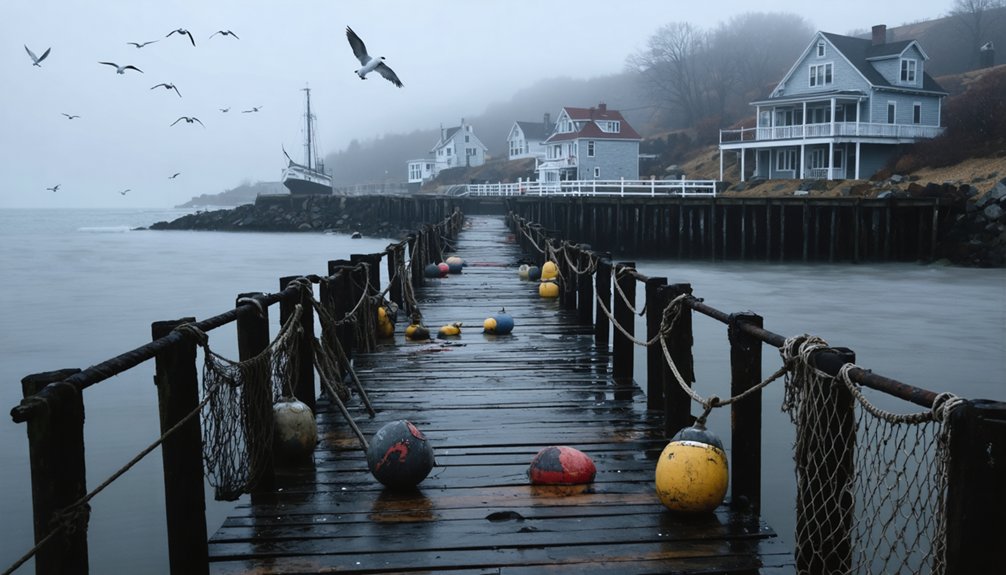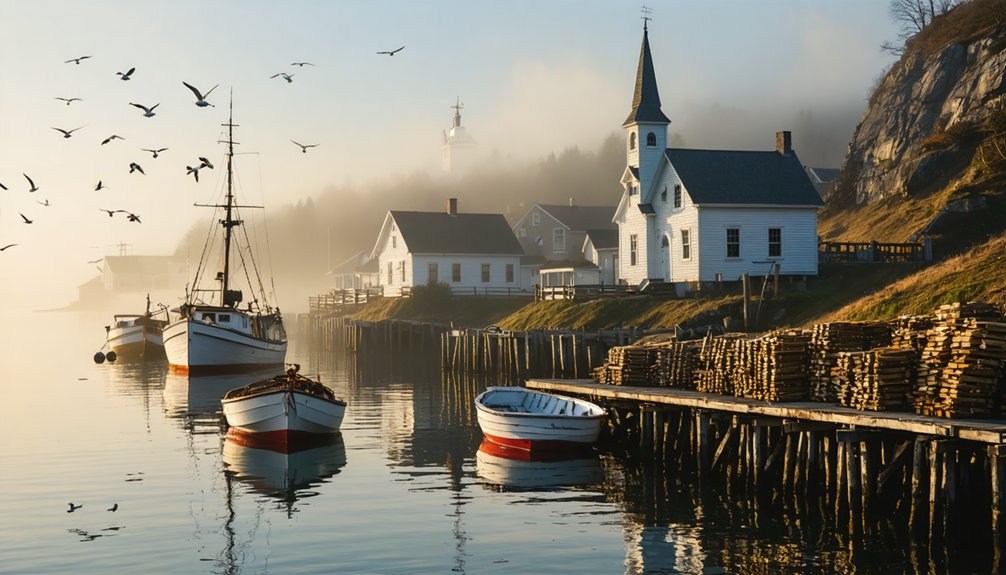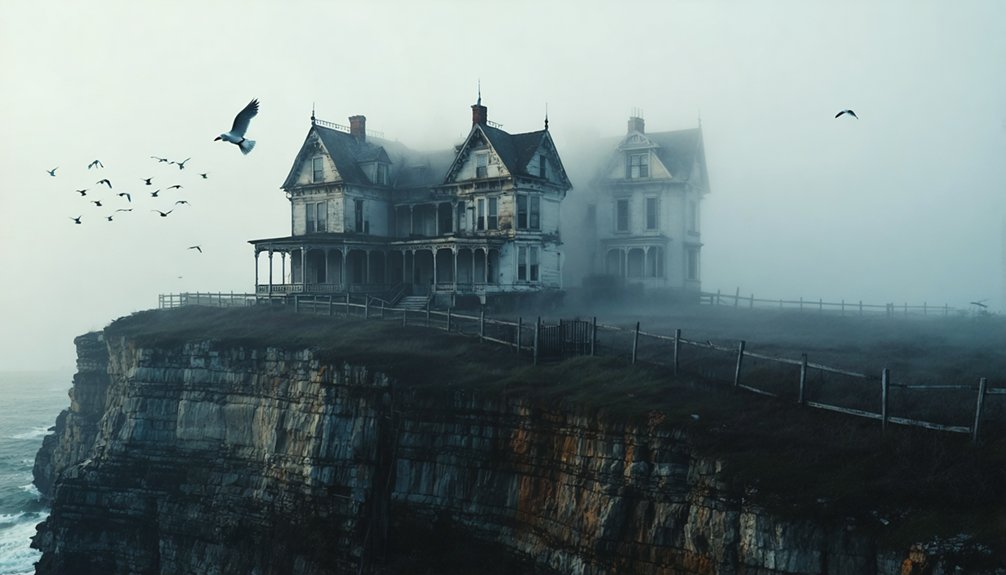Along America’s eastern coastline, you’ll discover haunting settlements frozen in time. Explore Roanoke Colony, where 117 settlers mysteriously vanished, leaving only the word “CROATOAN” carved in a post. Wander through Dogtown’s boulder-marked ruins in Massachusetts or witness the weathered structures of Cape Lookout Village standing silent against the Carolina shore. These ghostly coastal communities tell tales of nature’s wrath, human resilience, and secrets still waiting in the misty threshold where land meets sea.
Key Takeaways
- Cape Lookout Village in North Carolina features twenty weathered, abandoned structures alongside the iconic lighthouse.
- Whitewash Village on Monomoy Island, Massachusetts was completely erased by a violent hurricane after thriving since 1710.
- Dogtown in Gloucester, Massachusetts contains 30 inscribed boulders marking former homes along an eerie historical trail.
- Roanoke Colony on Roanoke Island remains America’s original ghost town, where 117 settlers mysteriously vanished.
- Neskowin Ghost Forest reveals 2,000-year-old tsunami-preserved stumps that emerge during low tide along the coast.
Gilchrist, Texas: The Stilt Town That Vanished Overnight

Perched precariously along the Gulf of Mexico on Texas’s Bolivar Peninsula, Gilchrist once stood as a tribute to human determination against nature’s fury.
You’d find homes elevated on stilts, their owners defying the ocean’s threats with stubborn coastal rebuilding after each storm.
Then came September 13, 2008. Hurricane Ike released a 14-foot surge topped by massive waves, leaving only the Adams’ home standing in its section—a lonely sentinel amid total devastation.
This solitary structure, raised 14 feet above the unforgiving terrain, became an icon of hurricane resilience.
The town that vanished overnight tells a haunting story of freedom’s price in vulnerable places.
Positioned at the narrowest point of the peninsula, Gilchrist was uniquely exposed to the hurricane’s destructive forces from multiple directions.
The town’s famous Rollover Pass connects East Bay to the Gulf of Mexico and remains one of the most popular fishing spots in Texas.
Like the abandoned Indianola before it, Gilchrist’s ruins whisper warnings about our tenuous relationship with the sea.
Cape Lookout Village: Where Silver Houses Stand Empty
While mainland tourists flock to North Carolina’s famous Outer Banks, few venture to the ghostly silver houses of Cape Lookout Village. Here, twenty weathered structures stand in coastal isolation, whispering tales of a vanished community that once thrived alongside the iconic lighthouse.
While vacationers crowd the Outer Banks, Cape Lookout Village remains a forgotten ghost town of silvery sentinels beside its stoic lighthouse.
You’ll walk where the last permanent residents departed nearly a century ago, leaving behind Queen Anne cottages and Craftsman bungalows that now serve as monuments to maritime life.
During WWII, soldiers temporarily revived these spaces as strategic defense posts, but the military’s departure only deepened the abandonment.
The village’s historic preservation status protects these time capsules from development, keeping this slice of barrier island authentically frozen. Visitors who explore the site should prepare for a journey with bug spray and good walking shoes to fully experience this well-preserved historical district.
These abandoned homes stand in stark contrast to the Diamond Lady, which continues to flash its distinctive light every 15 seconds throughout the night.
As you explore between empty homes and the abandoned Life-Saving Station, only the lighthouse still serves its original purpose.
The Lost Settlement of Whitewash Village
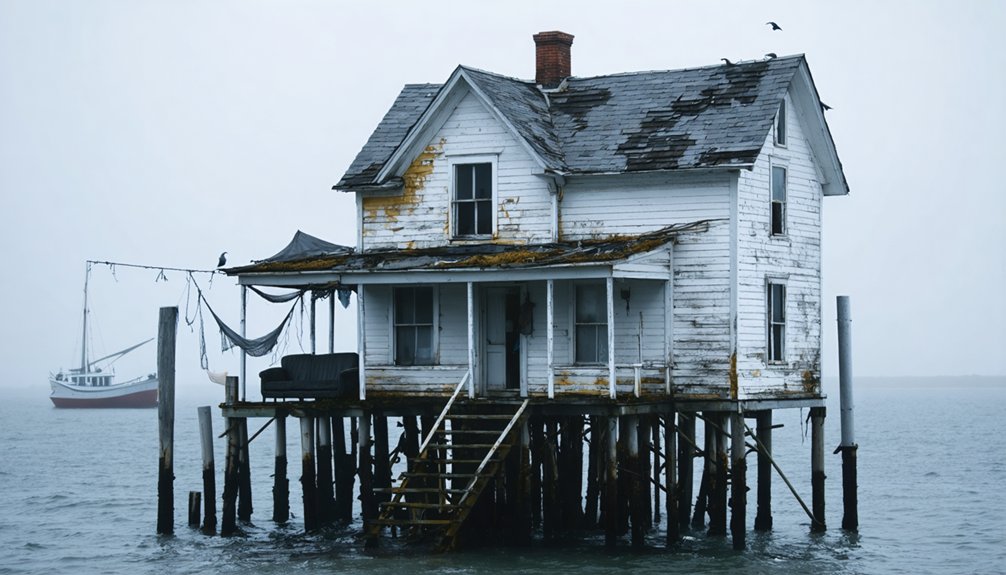
On the windswept shores of Monomoy Island, Massachusetts, you’ll find only whispers of Whitewash Village, a settlement that vanished almost as mysteriously as it appeared. Founded in 1710, this maritime heritage site once thrived with 200 souls who braved the elements, fishing for cod and mackerel in the deep natural harbor. The village’s architecture, with its whitewashed houses and wooden frames, bears striking resemblance to the aesthetic later popularized in coastal Turkey.
- Ghost-like footprints of cottages where families once dreamed of prosperity
- The haunting absence of the Monomoy House, where sailors once shared tales over warm drinks
- Silent echoes of 16 children learning their letters in a now-vanished schoolhouse
- The sudden, violent hurricane that erased an entire way of life in mere hours
- Nature’s brutal reminder of coastal vulnerability, as the sea reclaimed what was never truly ours
Dogtown: Carved Stones and Cellar Holes
The mist hangs heavy among the ancient trees of Dogtown, a forgotten domain in the heart of Gloucester, Massachusetts. This abandoned settlement, once home to 100 families before its post-Revolutionary decline, now whispers its Dogtown history through silent stone foundations and moss-covered cellar holes.
As you wander these haunted five square miles, you’ll discover the peculiar legacy of Roger Babson – over 30 massive boulders bearing inspirational inscriptions carved during the Great Depression. The area was abandoned due to its rocky, unproductive soil, making farming nearly impossible for its inhabitants.
“Never try never win,” “Stay out of Debt,” and “Loyalty” emerge from the wilderness, messages etched by Finnish stonecutters hired during desperate times.
Each numbered boulder marks where a home once stood, creating an eerie trail through time. Today, Dogtown is protected as part of the municipal watershed, which includes both Goose Cove and Babson Reservoirs. The forest has reclaimed Dogtown, but these stone sentinels remain, inviting you to discover their cryptic wisdom.
Roanoke Colony: America’s Original Ghost Town Mystery
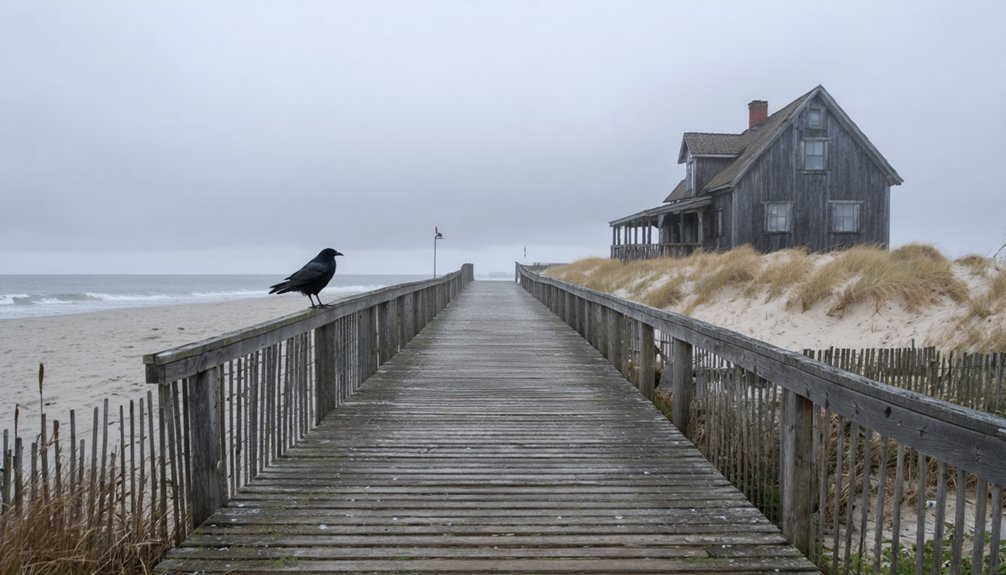
When you wander the ghostly shores of Roanoke Island today, you’re treading upon America’s most enduring mystery, where the cryptic word “CROATOAN” carved into a post remains our only clue to the fate of 117 vanished settlers.
You might feel the whispers of competing theories as you explore—perhaps the colonists integrated with Native tribes, succumbed to the region’s catastrophic drought, or scattered inland seeking survival.
The colony’s disappearance during the worst drought in 800 years suggests a harrowing environmental backdrop to whatever fate befell these pioneers, leaving you to wonder what secrets still lie buried beneath centuries of coastal sand and forest. John White, who had returned to England for supplies, was heartbroken to find the colony vanished upon his return three years later. The settlement had been established by Sir Walter Raleigh as an ambitious attempt to create the first permanent English settlement in North America.
Croatoan Cipher’s Legacy
Carved into weathered colonial wood and left to whisper through centuries, the word “CROATOAN” stands as America’s most haunting historical text message—a cryptic clue to the fate of 117 souls who vanished without a trace from Roanoke Island in 1587.
When you visit this windswept shore today, you’re walking in the footsteps of America’s enduring colonial mystery. The cipher’s legacy haunts our collective imagination, its meaning neither confirming tragedy nor salvation. Without the Maltese cross signifying distress, hope lingers that the settlers found refuge among friendly natives.
- The ghostly lettering remains the only voice of the vanished
- Archaeologists still sift coastal soil seeking truth beneath the legend
- Each artifact unearthed bridges centuries of silence
- You’ll feel history’s weight when standing where Governor White made his discovery
- Their final message calls to us still, across time’s vast distance
Theories Beyond Disappearance
Beneath the veil of historical amnesia, Roanoke’s ghostly absence continues to birth theories as numerous as the stars that guided colonial ships to these shores.
You’re standing where one of history’s most punishing droughts once parched the land during the colony’s final days—a climate impact so severe tree rings still testify to its brutality 800 years later.
Perhaps you’ll trace the footsteps of desperate settlers who carved “CROATOAN” before fleeing toward indigenous alliances on Hatteras Island.
Or imagine colonial ships battered by hurricanes that ravaged their timber homes while England’s attention was diverted by Spanish warships across the Atlantic.
The truth may lie in this delicate dance between environmental catastrophe and human adaptation—where colonists, abandoned by their motherland, either perished or transformed into something neither fully English nor Native.
Neskowin Ghost Forest: When Ancient Trees Became Sentinels
As you wander the misty shores of Neskowin, you’ll encounter the haunting remains of a 2,000-year-old Sitka spruce forest—silent witnesses to an ancient tsunami that forever altered this coastline.
These weathered sentinels, uncovered during the powerful El Niño storms of 1997-98, serve as nature’s own time capsule, preserving evidence of catastrophic geological events that would otherwise be lost to history.
Standing among these barnacle-encrusted ghosts during low tide, you’ll feel an eerie connection to a distant past when towering 200-foot giants dominated this landscape before being entombed by sand and sea.
Ancient Tsunami Evidence
The ancient sentinels of Neskowin Beach tell a haunting tale of destruction that occurred over three centuries ago. As you walk among the exposed stumps during low tide, you’re witnessing direct evidence of the 1700 Cascadia megathrust earthquake and subsequent tsunami impact.
This catastrophic event caused the coastal geology to suddenly subside, drowning the once-towering Sitka spruces in saltwater and preserving their remains in anaerobic sand.
- The ghostly stumps emerge only when the ocean temporarily retreats
- Each weathered stump whispers of a violent earth that shook without warning
- Marine creatures now make homes in wood that once reached toward the sky
- The forest’s preservation serves as nature’s own tsunami warning system
- Standing where ancient trees died reminds you of nature’s raw, untamed power
Silent Witnesses Emerge
Hidden beneath the shifting sands of Neskowin Beach, ancient wooden sentinels waited patiently for centuries until violent winter storms in 1997-1998 finally revealed their secrets to modern eyes.
You’ll find over 100 Sitka spruce stumps—once towering 200-foot giants—now exposed by coastal erosion and preserved by saltwater that inhibited decay.
Unlike ghost forests created by sudden earthquakes, Neskowin’s trees were gradually entombed by advancing sand dunes, sealing them from oxygen and time.
Today, these hollow remnants host a fascinating ancient biodiversity experiment—barnacles and mussels cling to their weathered surfaces while temporary tide pools shelter crabs and small fish.
As you wander among these 2,000-year-old monuments during low tide, you’re touching an eerie connection between past and present, between land and sea.
Natural Time Capsule
Beneath the rhythmic waves of Neskowin Beach lies a geological enigma frozen in time—a natural time capsule that defies the normal progression of decay.
You’ll witness the remarkable ancient preservation of 2,000-year-old Sitka spruce, entombed by catastrophic seismic events that plunged an entire forest beneath the sea in 1700. The salt water became their unlikely savior, preventing fungal decay while sand and sediment cradled their remains.
- Barnacle-encrusted sentinels standing in silent testimony to Earth’s raw power
- Hollow centers forming otherworldly tide pools where tiny creatures now make their homes
- Ghostly silhouettes emerging from the sand like forgotten guardians of a lost world
- Time-blackened wood bearing witness to centuries of crashing waves
- Nature’s memory made tangible—touchable history beneath your wandering feet
Frequently Asked Questions
Are Any of These Ghost Towns Safe to Visit Alone?
You can explore accessible towns like Perkins alone, but take safety precautions: inform others of plans, carry essentials, and respect barriers. Solo exploration thrives with preparedness and weather awareness.
What Paranormal Activities Have Been Reported in These Abandoned Settlements?
You’ll encounter shadow figures, misty apparitions, ghostly footsteps, floating orbs, and chilling whispers. Ghost sightings abound at lighthouses, while haunted legends of warning spectres persist through generations in these forgotten places.
How Have Climate Change Impacts Accelerated Coastal Town Abandonment?
You’ve watched rising sea levels slowly drown coastal havens, creating ghost forests as saltwater creeps inland. Storms intensify, beaches vanish, and economic decline follows—pushing you toward higher ground as communities surrender to the tide.
Can Visitors Take Artifacts or Souvenirs From These Locations?
No, you can’t take artifacts. Leave only footprints as you wander these misty shores—artifact ethics demand preservation, and souvenir regulations protect these whispered histories for future explorers seeking windswept freedom.
What Preservation Efforts Exist to Document These Disappearing Coastal Communities?
$6.8 million funds living shorelines that preserve history as sea levels rise. You’ll find historical archives documenting fading legacies and community engagement projects where locals share stories beneath salt-weathered skies of vanishing coastal worlds.
References
- https://wicproject.com/travel/10-abandoned-seaside-places-in-america-that-were-once-tourist-hotspots/
- https://thetravelersfieldguide.com/field-note/ghost-towns-of-the-east-coast/
- https://newenglandhistoricalsociety.com/six-new-england-ghost-towns/
- https://www.geotab.com/ghost-towns/
- https://albiongould.com/ghost-towns-to-visit-in-the-states/
- https://wnaw.com/ma-ghost-towns-hiking/
- https://www.atlasobscura.com/lists/americas-best-preserved-ghost-towns
- https://cloudman23.wordpress.com/2008/09/17/location-of-gilchrist-house-confirmed/
- https://www.tshaonline.org/handbook/entries/gilchrist-tx
- https://aranfranklin.com/wp-content/uploads/2023/05/aran-franklin-engineering-cnn.pdf
